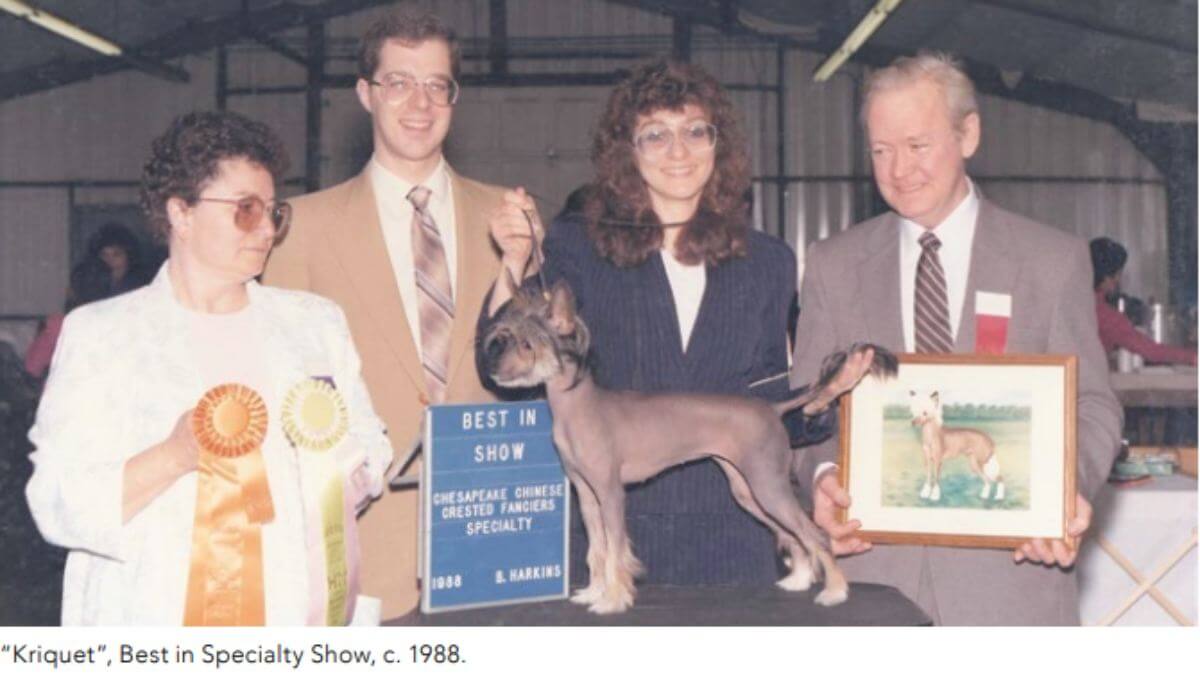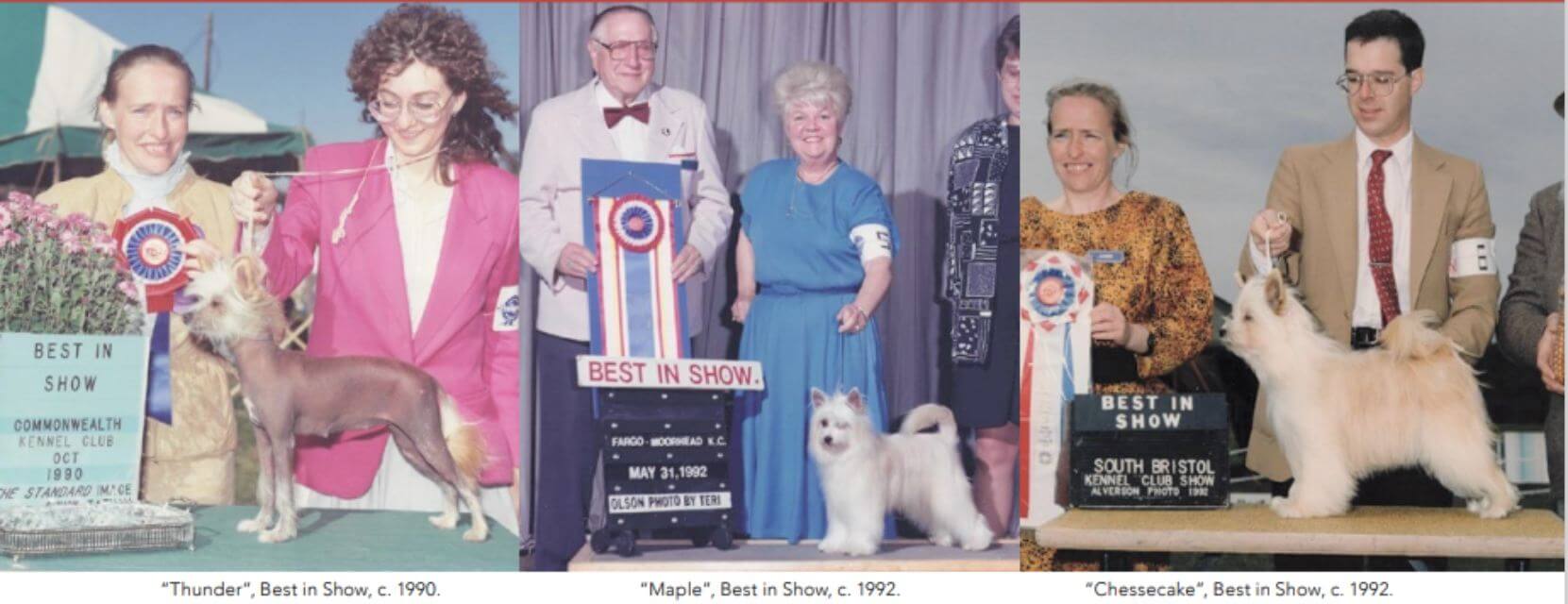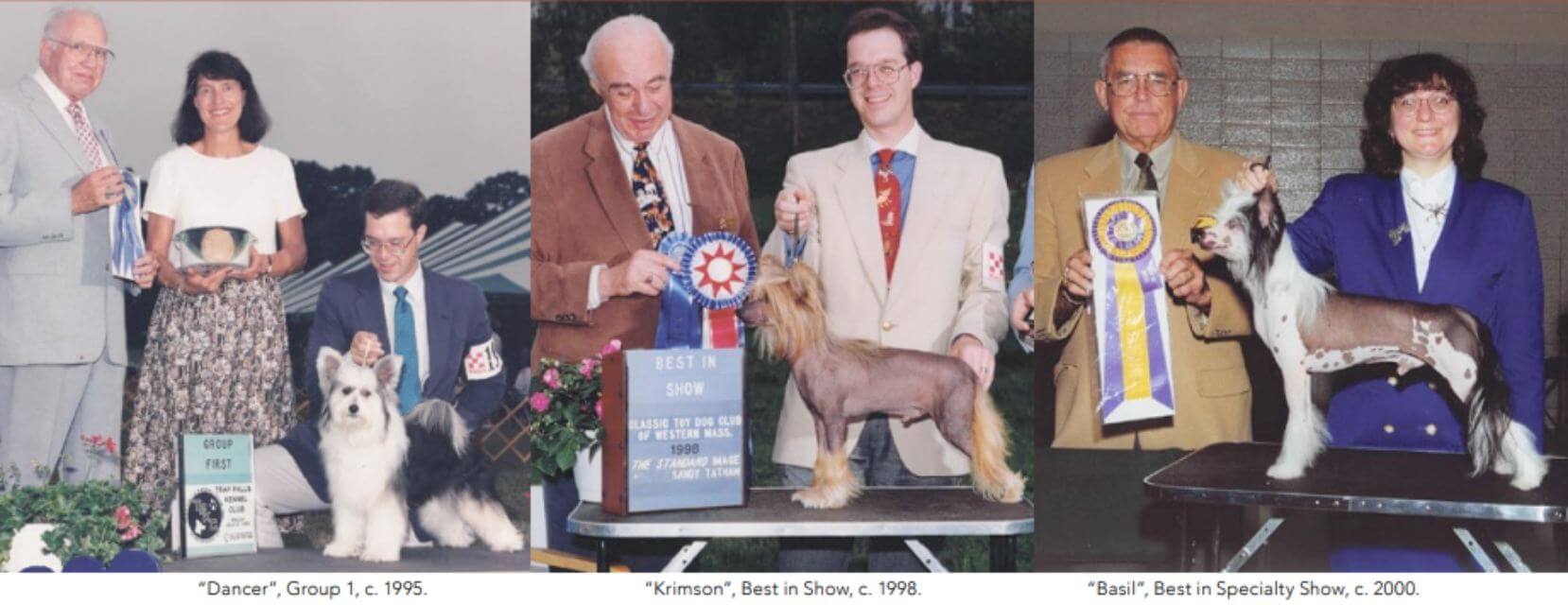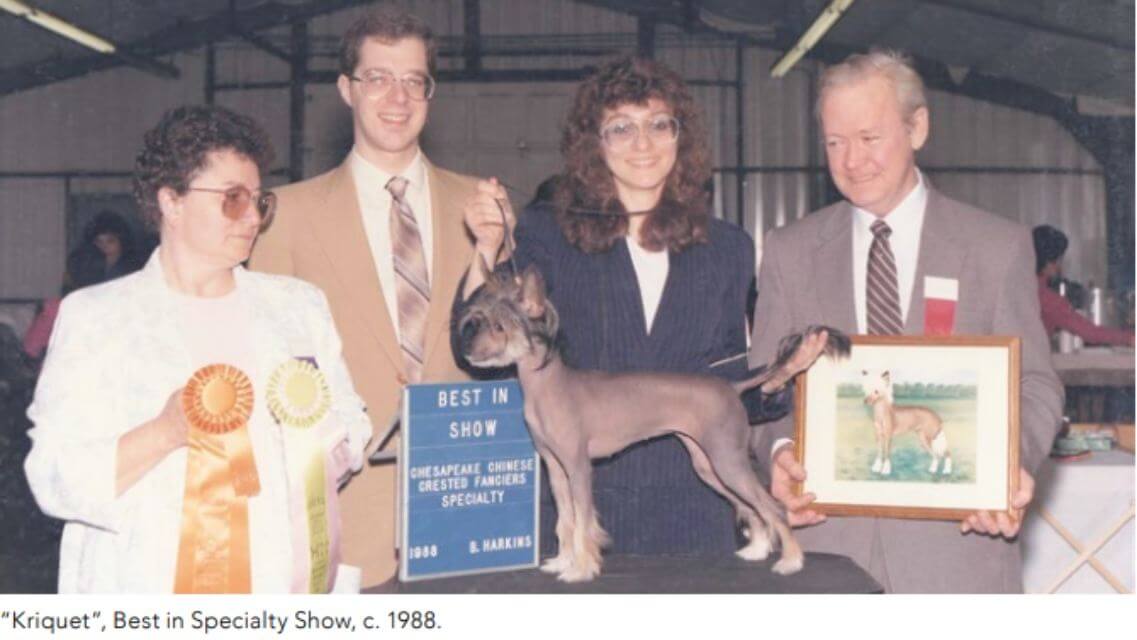
Home » A Blast From the Past – Chinese Cresteds

This article was originally published in Showsight Magazine, March 2015 issue.
In the years before American Kennel Club (AKC) recognition, Chinese Crested fanciers were limited to showing their dogs on the rare breed circuit. The shows of the time were extremely competitive, with many of the Crested fanciers making treks cross country to compete with their dogs. These early specialties often had over 50 dogs, which was remarkable since there were not many Cresteds in the country. Crested fanciers had to unite to show, as there were few opportunities to compete.
During the time before AKC recognition, the Chinese Cresteds were shown as two varieties with each variety (e.g., the hairless and the powderpuff) being awarded a set of points. In addition, both the hairless and powderpuff were represented in the group. When hairless dogs were presented in the pre-AKC show ring, they were absolutely hairless, with hair on the head, feet, and tail only. Exhibitors would not show dogs with less-than-optimal placement of hair as indicated by the standard. The hairless crest stopped “at the stop” and did not grow down the neck of the dog.
Additionally, Cresteds that were hairless were shown with the hair on the ears and the face. Rarely, if ever, would a hairless muzzle be trimmed. Similarly, the hair on the feet was confined to the toes of the dog. It never came up the leg, and was not trimmed. The skin on the hairless was soft and supple, like that of a baby’s bottom. Any pimples or blackheads were not favored. Early breeders did not accept any body hair on the dogs at all. It was clear that hairless dogs had to be hairless. And when looking at them untrimmed, there was no doubt at all that they were really born hairless. The powderpuffs are the completely coated counterpart to the hairless variety. They were shown completely natural with hair on the face and ears, as well as all over the body.

Powderpuffs were considered a “wash and show” kind of dog. The maintenance was minimal, and the standard reflected the desire to keep them natural. In England, the powderpuffs were a different kind of dog than in the US. They were much larger, had excessive coats, and they were shown with drop ears and trimmed faces. In speaking to some fanciers of the breed overseas, the term “Afghan type” was used to describe the puffs. Prior to AKC recognition, the standard specified that the Crested’s eye color should be “so dark as to appear black.” Thus, the early standard disallowed all light eyes and also disqualified blue eyes.
Later, the palomino colors, which are self-colored dogs, were permitted to have a lighter (amber) eye, and a liver nose. Chocolates are a variation of palomino with a medium brown eye and a brown nose. All other colors of hairless and powderpuffs must have black noses, with corresponding dark eyes. In addition, early standards also provided that the hairless had no extra hair to hide any imperfections, and glamour was not a deciding factor in selecting a winner. Having a hairless with excessive hair was considered a fault. Less hair and more skin, with good movement was the trait that was selected for. This early standard also addressed grooming. For example, a modified trim was introduced to the powderpuffs in America and was reflected in the standard.
Additionally, the original standard was changed to fit the style of the time by permitting the option of trimming faces and/or ears only in either variety, should the exhibitors desire. But, the standard did not prefer one grooming style as compared to another style. Thus, a powderpuff would not be rewarded if its coat were trimmed into a V shape on its neck or if trimming extended past the dog’s Adam’s Apple. This was not and is still not considered acceptable as the trimming is not confined to the face and ears as indicated by the standard.
AKC officially recognized the Chinese Crested breed and the American Chinese Crested Club (ACCC) in April 1991. The first official AKC show for Chinese Cresteds was Monday, April 1st (April Fool’s Day) and the top dogs in the breed showed up to vie for the first set of AKC points for the breed. Questions and intrigue filled the crowd, as the first AKC breed with a hairless variety competed for the first time.

Since there were only a few Cresteds in the USA as compared to other breeds, the spectators lined the ring four layers thick, with all eyes on the first dogs to be exhibited. There were oohs and aahs heard when the hairless variety entered the ring, and even more shock when the world was introduced to the powderpuff. For people unfamiliar with the breed, it was difficult to understand how these different looking dogs could be one breed. Shirley Tomas was the first judge for the breed. She put up a hairless, Razzmatazzmanian Stripper, for Best of Breed, and a powderpuff Gingerys Maple Syrup for the Best of Opposite. Both dogs were lovely examples of the breed, were representative of the standard, and went on to be the top two dogs for the breed.
The following months of showing proved that the hairless variety was what most people believed that a Crested should be like, while powderpuffs were virtually ignored. Although the standard provided that both varieties were to be given equal consideration, it was clear in those early days that powderpuffs were viewed as second-class citizens. There was also controversy surrounding what constituted an appropriate look for the powderpuff variety.
Some puffs were as natural as can be, with full faces and ears, while others were trimmed, with their ears, faces, necks, tails, feet, and even the body being scissored. Judges’ education programs were still in their adolescent stages and many people just did what they wanted, or what they thought would win. There was also talk of separating the hairless and puff varieties again, but from a breeder’s point of view, this would be undesirable for the breed. The two varieties are genetically connected, and the powderpuffs are normal with regard to dentition and coat type.
The hairless variety is the result of a dominant genetic mutation for which there is a lethal combination that can result in hairless to hairless crosses. No one in the breed wanted this to occur. Because powderpuffs are one third of the gene pool in the breed, they are a necessary element to keeping the breed alive. It was ultimately two powderpuffs that demonstrated the sound and fine quality of puffs. First, ACCC champion, 12-time Best In Specialty Show winner, and 2-time National Specialty winner, Ch. Gingery’s Maple Syrup, came out to play in the AKC world.

This dog was a well-balanced and sound toy dog that was shown natural and untrimmed. He not only was a great winner in the AKC, being the first AKC all-breed Best in Show-winning puff, but also he had the temperament that enabled him to perform well in agility, obedience, and therapy work. Barbara Beissel was hired to campaign this dog on the national level to get the powderpuff variety known. And on the East Coast, Victor Helu handled Maple Syrup’s Best in Show-winning daughter, Ch. Gingery’s Cheesecake, to many accolades. Maple Syrup made history early the next year by being the first multiple Best of Breed Westminster winner, as he went on to win the first two Chinese Crested Best of Breeds in Westminster. Both of these puffs paved the way for the powderpuff variety to get recognition as an equal partner to the hairless variety of the Chinese Crested.